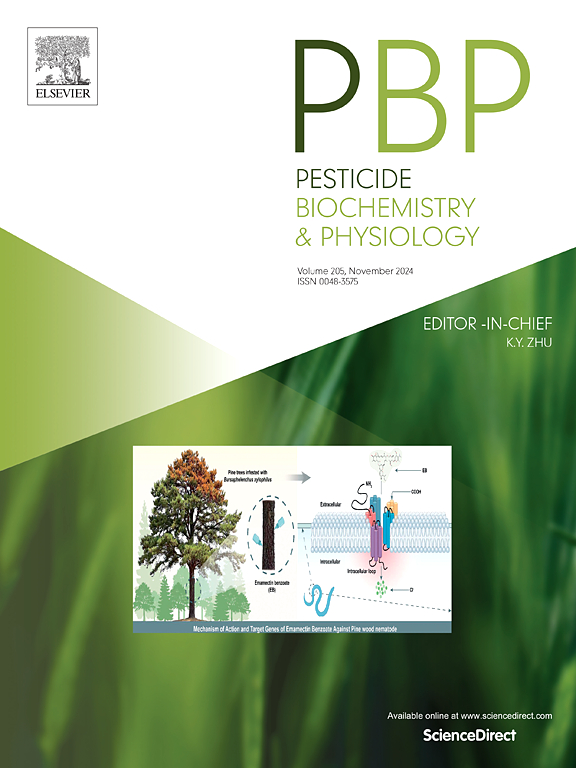NADPH-cytochrome P450 reductase mediates resistance to neonicotinoid insecticides in Bradysia odoriphaga
IF 4.2
1区 农林科学
Q2 BIOCHEMISTRY & MOLECULAR BIOLOGY
引用次数: 0
Abstract
As a crucial electron transfer partner of the P450 system, NADPH-cytochrome P450 reductase (CPR) plays an influential role in P450-mediated detoxification metabolism of xenobiotics. CPR has been found to be associated with insecticide resistance in several insects. However, the role of CPR in the cross-resistance of Bradysia odoriphaga to clothianidin and neonicotinoid insecticides remains to be elucidated. In this study, the CPR gene (BoCPR) of B. odoriphaga was cloned and characterized. The expression of BoCPR was more abundant in the adult stage and in the midgut and Malpighian tubules of larvae, and BoCPR was significantly overexpressed in the clothianidin-resistant (CL-R) strain compared to the susceptible (SS) strain. Exposure to clothianidin significantly increased BoCPR expression in both the SS and CL-R strains. In addition, knockdown of BoCPR in SS and CL-R strains significantly reduced CPR and P450 enzyme activities, and resulted in a significant increase in larval susceptibility to clothianidin, imidacloprid, and thiamethoxam. These results suggest that BoCPR plays an important role in B. odoriphaga resistance to clothianidin and cross-resistance to neonicotinoid insecticides.

nadph -细胞色素P450还原酶介导嗜臭慢蝇对新烟碱类杀虫剂的抗性
nadph -细胞色素P450还原酶(cytochrome P450 reductase, CPR)作为P450系统重要的电子传递伙伴,在P450介导的外源药物解毒代谢中发挥重要作用。已发现CPR与几种昆虫的杀虫剂抗性有关。然而,CPR在嗜臭迟缓虫对噻虫胺和新烟碱类杀虫剂的交叉抗性中的作用仍有待阐明。本研究克隆并鉴定了嗜臭芽孢杆菌的CPR基因(BoCPR)。BoCPR在成虫期、幼虫中肠和马尔比氏小管中表达量更丰富,且在clothianidin抗性菌株(CL-R)中表达量明显高于敏感菌株(SS)。暴露于clothianidin显著增加了SS和CL-R菌株中BoCPR的表达。此外,SS和CL-R菌株中BoCPR的敲低显著降低了CPR和P450酶的活性,并导致幼虫对噻虫胺、吡虫啉和噻虫嗪的敏感性显著增加。这些结果表明,BoCPR在嗜臭白蝇对噻虫胺的抗性和对新烟碱类杀虫剂的交叉抗性中起重要作用。
本文章由计算机程序翻译,如有差异,请以英文原文为准。
求助全文
约1分钟内获得全文
求助全文
来源期刊
CiteScore
7.00
自引率
8.50%
发文量
238
审稿时长
4.2 months
期刊介绍:
Pesticide Biochemistry and Physiology publishes original scientific articles pertaining to the mode of action of plant protection agents such as insecticides, fungicides, herbicides, and similar compounds, including nonlethal pest control agents, biosynthesis of pheromones, hormones, and plant resistance agents. Manuscripts may include a biochemical, physiological, or molecular study for an understanding of comparative toxicology or selective toxicity of both target and nontarget organisms. Particular interest will be given to studies on the molecular biology of pest control, toxicology, and pesticide resistance.
Research Areas Emphasized Include the Biochemistry and Physiology of:
• Comparative toxicity
• Mode of action
• Pathophysiology
• Plant growth regulators
• Resistance
• Other effects of pesticides on both parasites and hosts.

 求助内容:
求助内容: 应助结果提醒方式:
应助结果提醒方式:


